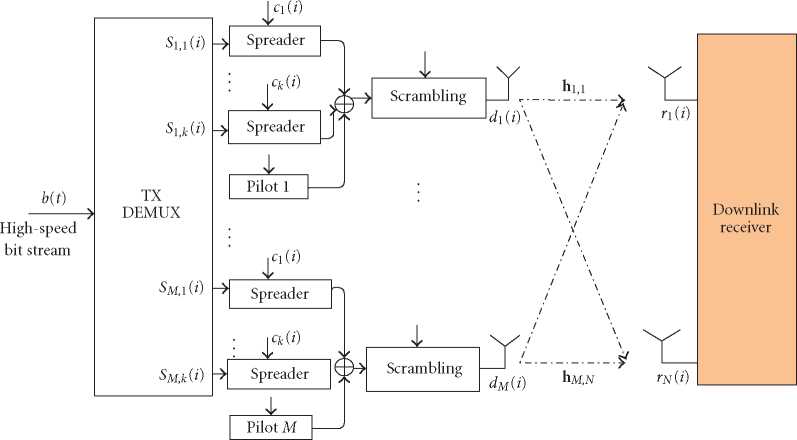Yuanbin Guo et al.

Figure 1: The system model of the MIMO multicode CDMA downlink.
chip from all the N Rx antennas, we form a signal vector as
rA = [r(i+F)T, ...,r(i)T,...,r(i-F)T]T.Here,F is the obser-
vation window length corresponding to the channel length.
In the vector form, the received signal can be given by
M
rA(i) = Hmdm(i), (2)
m=1
where Hm is a block Toeplitz matrix constructed from the
channel coefficients as shown in [20]. The multiple receive
antennas’ channel vector is defined as hm (l) = [hm,1 (l),
..., hm,n(l), ..., hm,N (l)]T. The transmitted chip vector for
the mth transmit antenna is given by dm(i) = [dm(i +
F),...,dm(i),...,dm(i-F-L)]T.
3. LMMSE TAP SOLVER WITH CIRCULANT
APPROXIMATION
3.1. LMMSE chip equalizer
LMMSE chip-level equalization has been one of the most
promising receivers in the single-user CDMA downlink.
Chip equalizer estimates the transmitted chip samples by a
set of linear FIR filter coefficients wH(i) to restore the code
orthogonality as
^ . TT
d m ( i ) = WH ( i )rA ( i ).
(3)
It is well known that the LMMSE chip equalizer coefficients
are given by minimizing the MSE between the transmitted
and recovered chip samples as
where σj(i) is the transmitted chip power. Rrr(i) and hm(i)
are the covariance estimation and channel estimation, re-
spectively. Here, the covariance matrix is estimated by the
time-average with ergodicity assumption as
1 NB -1
Rrr(i) = E [rA(i)rH(i)] = — ɪ rA(i)rH(i), (5)
NB i=0
where NB is the length for the time average. The channel co-
efficients are estimated as hm(i) = E[rA(i)dHm(i)] using the
pilot symbols. In the HSDPA standard, about 10% of the to-
tal transmit power is dedicated to the common pilot chan-
nel (CPICH). This will provide accurate channel estimation.
By assuming that the channel is stationary over the observa-
tion window length, we can have a block-based operation by
omitting the chip index in Rrr(i), hm(i), and wm(i).
3.2. FFT-based circulant approximation tap solver
Using the stationarity of the channel and the convolution
property, it is easy to show that the covariance matrix is a
banded block Toeplitz matrix as
|
∕E[0] ■ .. |
■■ EH [L] ■ |
■ 0 ʌ . . | ||
|
Rrr = |
. E[L] . .. |
. .■ . .. . .■ |
■ . ■■ EH[L] .. |
, (6) |
|
. . ∖ 0 ■ |
. . ■■■ ■■ E[L] ■ |
.. ■■ E[0] |
wmpt(i) = argminE ∣^∣∣dm(i) - wH(i)ra(i)∣∣21
Wm ( i ) (4)
= σd2( i )R rr ( i )- 1h m ( i ),
where E[l] is an (N × N) block matrix with the cross-
antenna covariance coefficients. The dimension of the ma-
trix is (NLF × NLF ), where LF is determined by the channel
length L. In an outdoor environment, LF could be up to 32.
More intriguing information
1. The name is absent2. The name is absent
3. The name is absent
4. The name is absent
5. The name is absent
6. BODY LANGUAGE IS OF PARTICULAR IMPORTANCE IN LARGE GROUPS
7. Implementation of Rule Based Algorithm for Sandhi-Vicheda Of Compound Hindi Words
8. The name is absent
9. The name is absent
10. Design and investigation of scalable multicast recursive protocols for wired and wireless ad hoc networks